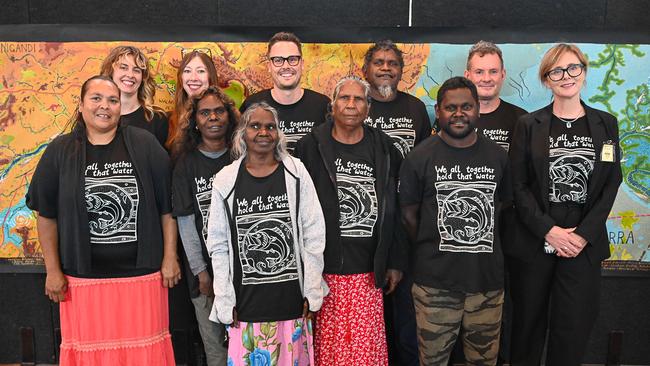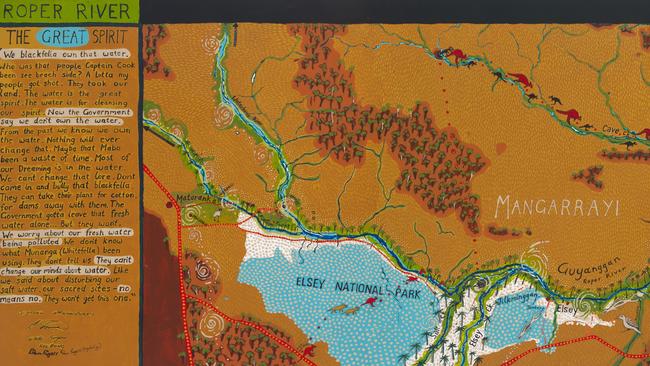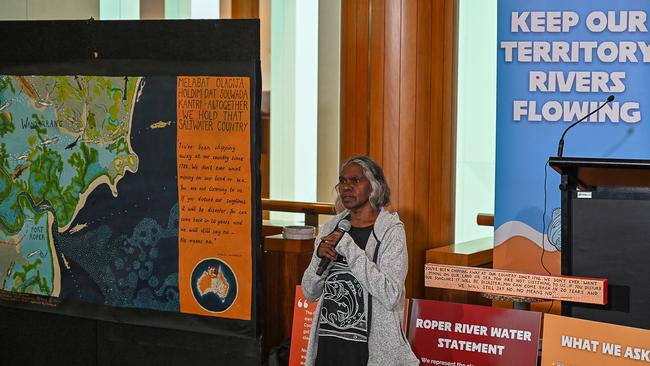Arnhem Land traditional owners petition to protect Roper River from cotton industry
Traditional owners from across the NT travelled to Canberra, calling for protection of Territory’s second largest river.
News
Don't miss out on the headlines from News. Followed categories will be added to My News.
Arnhem Land traditional owners travelled to Canberra this week to present a 13-metre map petition to federal parliament to protect the NT’s second largest river.
The petition asked for the Roper River to be protected from threats posed by water intensive industries in the catchment like cotton.
The handpainted map and associated statement was signed by hundreds of remote community residents advocating for traditional owners to be at the forefront of all decision-making for the river.
Alawa traditional owner Naomi Wilfred said there were so many important springs including important cultural and dreaming sites that needed protection from big industries like cotton.
“We made that map to show Canberra about the water connection [and] the threat we’re worrying about is cotton is coming in and I think we’ll have no water left,” she said.
“We want to tell them to stop taking water and start listening to the rightful traditional owners,
“We want to see this river protected for our future generations.”

Big industries including cotton, fracking and mining have proposed to take hundred of thousands of litres of surface and groundwater from rivers including the Roper.
The cotton industry has flagged 100,000 hectares will be bulldozed for crops in the Northern Territory by 2030 however traditional owners argue that they weren’t properly consulted.
The delegation is calling on the federal government to acknowledge their Indigenous water rights, to implement proper consultation mechanisms about major water decisions, and for the whole of the river catchment to be properly protected.


Mitch Hart from the Pew Charitable Trusts, who supported the delegation to travel to Canberra, said mistakes made in the Murray Darlings could not be repeated.
“Water hungry industries, such as industrialised cotton production, are setting up shop along rivers like the Roper – despite the damage caused by over-extraction, bulldozing and pollution,” he said.
“Communities that live along the Roper and rely on it for survival are extremely concerned about its future,
“The federal government has an opportunity to respond to this powerful message from traditional owners and support communities who rely on these rivers.”
The map itself was made in collaboration with artist Simon Normand over 18 months and officially unveiled at an event in the Mural Hall of Australian parliament on Tuesday.
Meanwhile a group of supporters of gas development were also in the nation’s capital to put forward their case.

Environment, Climate Change and Water Security Minister Kate Worden said protecting natural resources was a priority for the Territory government.
“We know the importance of our water ways and rivers in the Arnhem region and the cultural significance they have for indigenous people of the Roper River region. Their protection is the primary consideration in water decisions,” she said.
Ms Worden also said there was currently no licensed extraction from the river for agricultural purposes including the growing of cotton.
“Obstruction of a river is not allowed under law and there are no proposals for dams. The Roper River remains a healthy free flowing river,” she said.
Surface water extraction for on shore gas is currently prohibited under the Water Act which also limits groundwater extraction for any horticultural or agricultural development along with water allocation plans.





